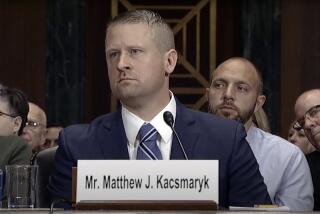Rising Legal Battles Tarnish Norplant’s Bright Promise : Birth control: Class-action claims charge severe health problems. Proponents of the device blame many problems on ill-trained doctors.
- Share via
It was anticipated for decades and arrived with great fanfare in 1990. But now Norplant--the first new birth control method offered to American women since oral contraceptives were introduced 25 years ago--is the target of an expanding pool of lawsuits alleging serious health problems.
About 100 Southern California women have joined a class-action lawsuit charging that the implanted hormone contraceptive--with a failure rate of only 0.04% when properly used--has caused them severe side effects and complications they were not warned about.
The women are among several hundred others nationwide who have filed more than a dozen lawsuits in recent months against Wyeth-Ayerst Laboratories, the Philadelphia-based U.S. distributor of Norplant.
The lawsuits--which charge such adverse side effects as depression and heavy bleeding as well as excessive scarring and pain from removal of the device--are a disappointing development for family planning experts who had heralded Norplant’s arrival. Since the lawsuits began, the number of women who have asked that the device be removed has risen dramatically while requests for Norplant have fallen, family planning clinics nationwide report.
“I’m sure the women who have joined in these lawsuits have good reason to do so, but I feel like it will have a chilling effect on other companies which might want to get into contraceptives research,” said Lisa Kaeser, a public policy analyst with the Alan Guttmacher Institute, a nonprofit research and policy organization in New York.
But unlike the thousands of lawsuits over silicone breast implants, which led to that product’s demise, many health experts predict that Norplant will survive the scrutiny over its safety and efficacy.
“Most women who have Norplant are happy with the method, and most who have had them removed have had no problem with removals. It’s unfortunate that some women have had problems, but I think they are in the minority,” said Sandra Waldman, a spokeswoman for the nonprofit Population Council, which developed Norplant after 20 years of testing.
“It’s a very well-researched method,” she said. “We conducted numerous studies in many countries with thousands of women participating in the trials. And hundreds of scientific articles have been written about Norplant. So we stand by the safety of the method.”
Government health officials also appear unworried by the lawsuits thus far.
“Essentially, the Food and Drug Administration is not seeing any (problems) that were not reported in clinical trials and are not above the rates found in clinical trials,” FDA spokeswoman Susan Cruzan said.
The government did approve revised product labeling submitted by Wyeth in July to alert consumers to possible side effects that were not seen before marketing of the device, including rare instances of stroke, phlebitis and birth defects.
But, Cruzan said: “That doesn’t necessarily mean there is a cause-and-effect relationship” between those ailments and Norplant.
Plaintiffs paint a much different picture of the risks. Norplant consists of six matchstick-size silicone rods that are implanted in the upper left arm, just under the skin. The synthetic hormone progestin, an ingredient in many birth control pills, is slowly released from the rods to prevent pregnancy. The implant can be left in place for up to five years.
Two major complaints--severe side effects and removal problems--have emerged in the lawsuits filed in Minneapolis, Miami, Chicago, Dallas and other cities, plaintiffs’ attorneys say. Dozens of potential side effects are listed in the product labeling by Wyeth, but some of those have been more severe than anticipated in some women, according to the lawsuits. A second common grievance focuses on the difficulty of removing the rods, which some women charge is much more painful, time-consuming and costly than Wyeth suggests in its product information brochure.
“The (product labeling) gives considerable warnings, but you can only go so far in how warnings are communicated to recipients,” said Arthur Sherman of Sherman, Dan & Portugal, a Beverly Hills firm representing the California women. “Most women didn’t realize the severity of the menstrual changes and length of the changes. The severity is really difficult for these women to handle.”
Although removal of the implant is described in informational brochures as a simple, 20-minute procedure that requires only local anesthesia and no stitches, Sherman says some women have conveyed horrendous experiences that require several surgeries and general anesthesia, leaving them with residual scarring and pain.
Among the women who have filed suit is Cindy, a Los Angeles flight attendant who is in her 20s and asked not to be identified. She received Norplant three months ago and said she began having severe headaches and anxiety about a month later. She was also dismayed at her irregular menstrual cycle.
“The severity has been a tremendous surprise in that I didn’t expect daily symptoms,” she said in an interview. “The side effects have disrupted my personal life. I just don’t enjoy all the activities I once did.”
Cindy said she would like to have Norplant removed, but after hearing reports of difficult removals, she is afraid to go through with it. She said she feels betrayed by her doctor and Wyeth. “‘I was looking into a long-term method, something safe and effective,” she said. “I thought Norplant would be the ideal method. I wish I had known then what I know now.”
The lawsuit filed in California’s Central District Court charges that Wyeth failed to warn women of the potential severity of side effects and removal problems. The suit also alleges a failure to adequately test the implant before marketing.
Proponents of Norplant say the problem is not the device but the training of health professionals inserting Norplant and the counseling and education provided to patients.
Kaeser, of the Guttmacher Institute, said: “Wyeth did do an extensive training (program) nationwide” on proper use of the device. “But there never has been anything to force a doctor or nurse practitioner to take the training before they do an insertion. A lot of the problems may be due to physician training.”
About 28,000 professionals have completed Wyeth’s training program, according to a company official. It is not known how many medical practitioners insert or remove Norplant devices without having undergone training.
Waldman, of the Population Council, said “usually when a removal is difficult, it’s because the insertion has not been done properly,” such as inserting the device too deeply in the arm.
According to Wyeth, more than 1 million U.S. women have received Norplant and about 15% have had the device removed. Complications in removal--usually the inability to remove all six rods in one surgery--occurred in 6% of cases, according to the premarketing clinical trials.
In a statement, Wyeth officials contend that class-action litigation “is inappropriate because Norplant removal is an individual procedure that is affected by a number of variables.”
Moreover, the statement asserted that the rate of removal complications continues to be below the rate anticipated before marketing.
Although problems with removing the device might be smoothed out as more practitioners gain experience, the controversy over Norplant’s side effects promises to be contentious. According to product labeling, women are warned of numerous possible side effects, including irregular bleeding, headaches, vomiting, dizziness, acne, weight gain and anxiety.
Some health experts are especially concerned that patient counseling prior to Norplant insertion may be inadequate because many users are very young, poor, uneducated or speak little English. Nationwide, about half of all Norplant recipients obtain the device through Medicaid.
Testing on Norplant began in 1975, and the device was first approved for use in Finland in 1983, according to the Population Council. Norplant is now approved in 39 countries, where few concerns over the method’s safety have arisen, said JoAnn Lewis, vice president for reproductive health at Family Health International, which has sponsored much of the research on Norplant in developing countries.
“One of the things other countries may have done better . . . is to train (health professionals) and provide counseling so that potential users know what to expect.”
Some health experts say clinics and private practitioners will redouble their efforts to seek proper training and provide extensive counseling to potential Norplant users. Local clinics are not expected to abandon the method, said Margie Fites Seigle, chief executive officer of the Los Angeles Regional Family Planning Council.
“We have had an increase in calls in our centers from women expressing concern about Norplant. It became almost a panicked reaction,” Seigle said. “But I do not anticipate that clinics would stop using it. I still truly believe that Norplant is a good method for those women who have been appropriately counseled and educated as to what to expect, and they go to a medical provider who has experience with it.”






